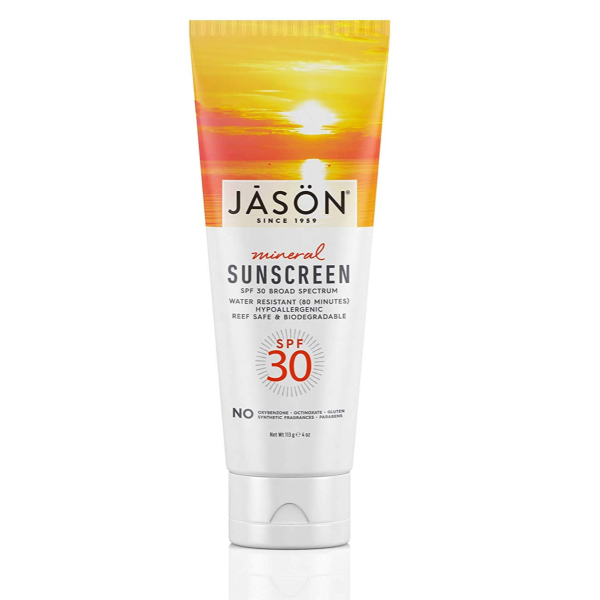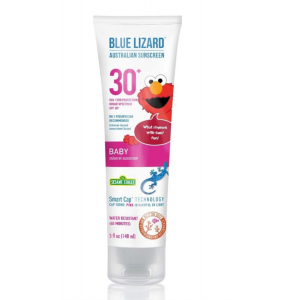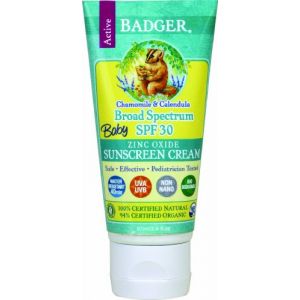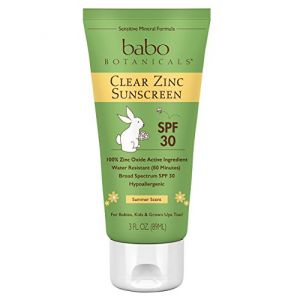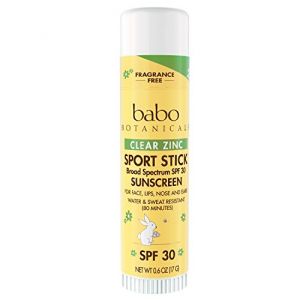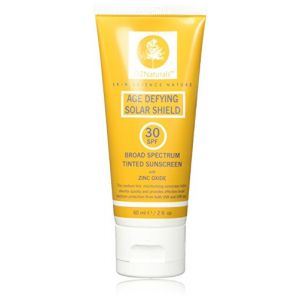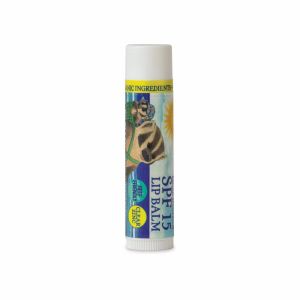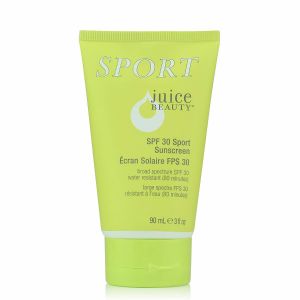- Pros:
- Hypoallergenic, broad spectrum sunscreen for sensitive skin
- The cruelty free formula is biodegradable, contains certified organic oils and extracts, and is specifically designed to provide protection from sun exposure.
- Reef safe
- Biodegradable
- Free of Oxybenzone, Octinoxate, Gluten, Parabens, Synthetic fragrances, Petrolatum, Phthalates, Artificial colors, and Animal testing (Cruelty Free)
- Water Resistant (80 Minutes)
- Hypoallergenic
- Made in the USA
Ingredients Concern: Benzyl alcohol; phenoxyethanol; Tocopheryl acetate; Dimethicone; Glyceryl isostearate
Cons: Cannot be used on damaged or broken skin, Exposure to the eyes should be avoided, Contains some ingredients that are moderately hazardous
In 1959, a group of Californians got tired of seeing harsh chemicals in the products they were using manufactured by big companies. They decided to focus on making body loving products with plant based ingredients and using the restorative power of nature's botanicals. Jason which is the Greek word for heale was deemed the name of the company. They then set a code of honor to include 1) Safe, gentle and effective ingredients, 2) Never testing on animals and 3) innovating and improving constantly. You won't find parabens, phthalates, harsh sulfates or artificial colors in their skin, body and haircare products.
Zinc has anti-inflammatory properties that help improve skin issues including acne, and it heightens the body's ability to promote wound healing [1-4].
JoJoba oil is commonly used for skin preparations including sunscreens as it slows down the skin aging process and reduces the incidence of skin infections [5]. Zinc oxide is frequently added to sunscreens as an inorganic physical sun blocker and a zinc-deficiency is associated with oxidative stress-induced aging due to free radicals and oxygen reactive species, which are skin-damaging particles that zinc targets [15, 16].
Titanium Dioxide helps protect the skin from UVA and UVB radiation [6, 15].
Helianthus annuus (sunflower) seed oil contains linoleic acid, oleic acid, stearic acid, palmitic acid, and vitamin E that helps create a protective barrier on the surface of the skin [7].
Shea butter is frequently used in skin care products and cosmetics due to its skin protecting properties [8, 9].
Jojobavitis vinifera (grape) seed oil and aloe barbadensis boost the body's natural would healing processes [10, 11].
Calendula officinalis flower extract demonstrates skin protection from UV radiation and it helps maintain skin pigmentation [12].
Camellia sinensis leaf extract contains antioxidants such as epigallocatechin-3-gallate (EGCG) which combat UV-induced DNA damage [14].
Skin health [1]; Protection from sun exposure [5]
Zinc improves the health through its ability to encourage detoxification and it has also been shown to boost wound healing due to its anti-inflammatory activity [1-4]. Zinc oxide is frequently added to sunscreens as it targets free radicals, thereby preventing them from damaging fibroblasts and lipids (fats) that play a role in protecting the skin from UV exposure or skin irritants (e.g., pollution) [15]. Zinc oxide is also linked to anti-aging due to its ability to protect collagen-producing fibroblast and lipids in the skin [16].
Zinc oxide creates a protective layer on the skin that blocks UV light and in doing so, it hinders UV rays from penetrating the skin. The structure of zinc oxide helps it mix easily with other topical agents and zinc does not absorb deeply into the skin [17], which reduces the occurrence of skin irritation and is one of the reasons why it is added to sunscreen for individuals with sensitive skin. These properties make zinc oxide a strong UV-blocking shield.
JoJoba oil is beneficial due to its anti-aging, wound healing, and anti-inflammatory activity, and it also helps enhance the absorption of other topical agents [5].
Titanium dioxide blocks UVA/UVB by reflecting and scattering it; in doing so it reduces the occurrence of sunburn and protects skin cells [6].
Helianthus annuus (sunflower) seed oil lessens the evaporation of the skin's natural moisture and heightens skin hydration by causing water to accumulate on the skin's surface [7].
Shea butter has potent anti-inflammatory and antioxidant properties that help it create a protective barrier on the skin [8, 9].
Jojobavitis vinifera (grape) seed oil and aloe barbadensis have anti-inflammatory properties that help restore and maintain the skin barrier [10, 11].
Calendula officinalis flower extract has antifungal, anti-inflammatory, and antibacterial properties that boost natural would healing processes [12].
Chamomilla recutita (matricaria) flower extract has soothing, anti-itch properties [13].
Green Tea contains EGCG, which is an antioxidant that targets oxidative stress-induced skin damage [14].
Key Ingredients: 14.5% Zinc Oxide; 2% Titanium Dioxide; helianthus annuus (sunflower) seed oil; shea butter; jojobavitis vinifera (grape) seed oil; simmondsia chinensis (jojoba) seed oil aloe barbadensis leaf juice; calendula officinalis flower extract; camellia sinensis leaf extract; chamomilla recutita (matricaria) flower extract
All Ingredients: 14.5% Zinc Oxide; 2% Titanium Dioxide; Aqua (water); caprylic/capric triglyceride; dimethicone; ethylhexyl palmitate; sorbitan sesquioleate; glycerin; glyceryl isostearate; butyrospermum parkii (shea) butter; polyglyceryl-3 ricinoleate; helianthus annuus (sunflower) seed oil; simmondsia chinensis (jojoba) seed oil; vitis vinifera (grape) seed oil; aloe barbadensis leaf juice; calendula officinalis flower extract; camellia sinensis leaf extract; chamomilla recutita (matricaria) flower extract; tocopheryl acetate, alcohol; magnesium sulfate; silica; sodium chloride; benzyl alcohol; phenoxyethanol; polyhydroxystearic acid
Apply liberally 15 minutes before sun exposure.
Reapply after 80 minutes of swimming or sweating, immediately after towel drying, or at least every 2 hour.
For children under 6 months, ask a doctor before use. When using this product keep out of eyes. Rinse with water to remove. Stop use and ask a doctor if rash occurs. If swallowed, get medical help or contact a Poison Control Center right away.
1. Is this Jason Mineral Sunscreen 100% vegetarian?
Other than Beeswax found in Cooling Minerals & Tea Tree Muscle Pain Therapy, Jason products contain ingredients that are almost 100% vegetarian. The Beeswax is sourced in a harm-free, stress-free, cruelty-free manner that does not impact the health or welfare of the bees.
These statements have not been evaluated by the FDA. These products are not intended to diagnose, treat, cure or prevent any disease.
References
1. Amer M, Bahgat MR, Tosson Z, et al. Serum zinc in acne vulgaris. Int J Dermatol 1982;21:481-4.
2. Dreno B, Trossaert M, Boiteau HL, Litoux P. Zinc salts effects on granulocyte zinc concentration and chemotaxis in acne patients. Acta Derm Venereol 1992;72:250-2.
3. Hodges RE, Minich DM. Modulation of Metabolic Detoxification Pathways Using Foods and Food-Derived Components: A Scientific Review with Clinical Application. J Nutr Metab. 2015;2015:760689.
4. Michaelsson G, Ljunghall K. Patients with dermatitis herpetiformis, acne, psoriasis and Darier's disease have low epidermal zinc concentrations. Acta Derm Venereol 1990;70:304-8.
5. Pazyar N, Yaghoobi R, et al. Jojoba in dermatology: a succinct review. G Ital Dermatol Venereol. 2013;148(6):687-91.
6. Chaudhuri RK, Majewski G. Amphiphilic microfine titanium dioxide: Its properties and application in sunscreen formulations. Drug Cosmet Ind 1998;162:24-31.
7. Danby SG, AlEnezi T, et al. Effect of olive and sunflower seed oil on the adult skin barrier: implications for neonatal skin care. Pediatr Dermatol. 2013;30(1):42-50.
8. Lin TK, Zhong L, Santiago JL. Anti-Inflammatory and Skin Barrier Repair Effects of Topical Application of Some Plant Oils. Int J Mol Sci. 2017;19(1). pii: E70.
9. Maranz S, Wiesman Z. Influence of climate on the tocopherol content of shea butter. J Agric Food Chem. 2004;52(10):2934-7.
10. Shivananda Nayak B., Dan Ramdath D., Marshall J.R., Isitor G., Xue S., Shi J. Wound-healing properties of the oils of Vitis vinifera and Vaccinium macrocarpon. Phytother. Res. 2011;25:1201-1208.
11. Hajhashemi M, Rafieian M, et al. The effect of Aloe vera gel and sweet almond oil on striae gravidarum in nulliparous women. J Matern Fetal Neonatal Med. 2018;31(13):1703-1708.
12. Mishra AK, et al. Assessment of In Vitro Sun Protection Factor of Calendula officinal L. (Asteraceae) Essential Oil Formulation. Journal of Young Pharmacists, 2012;4(1):17-21.
13. Lee SH, Heo Y, Kim YC. Effect of German chamomile oil application on alleviating atopic dermatitis-like immune alterations in mice. J. Vet. Sci. 2010;11:35-41.
14. Korać RR, Khambholja KM. Potential of herbs in skin protection from ultraviolet radiation. Pharmacogn Rev. 2011;5(10):164-73. 15. Smijs TG, Pavel S. Titanium dioxide and zinc oxide nanoparticles in sunscreens: focus on their safety and effectiveness. Nanotechnol Sci Appl. 2011;4:95-112.
16. Cabrera ÁJ. Zinc, aging, and immunosenescence: an overview. Pathobiol Aging Age Relat Dis. 2015;5:25592.
17. Mohammed YH, Holmes A, et al. Support for the Safe Use of Zinc Oxide Nanoparticle Sunscreens: Lack of Skin Penetration or Cellular Toxicity after Repeated Application in Volunteers. J Invest Dermatol. 2019;139(2):308-315.

